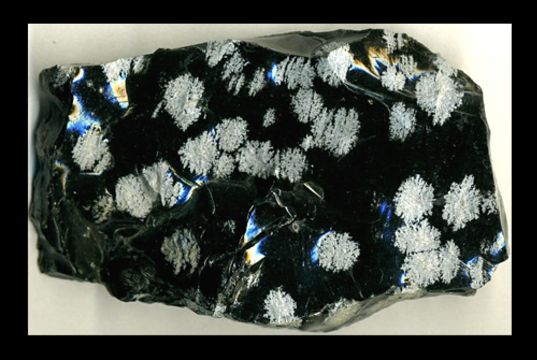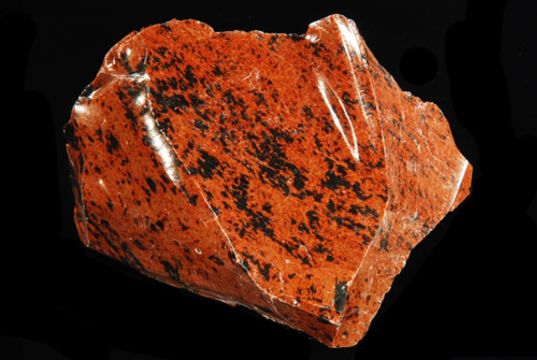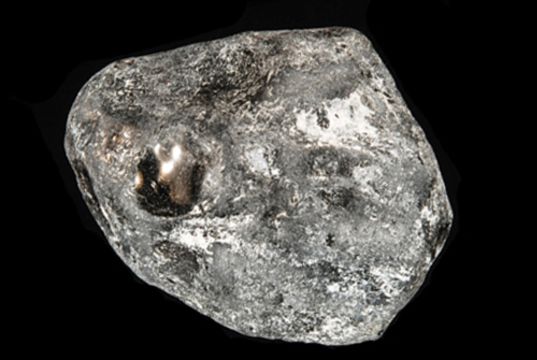Obsidian – Mineral and Healing Properties
Chemistry: SiO2; Mostly silicon dioxide with large amounts of impurities.
Class: Mineraloids
Uses: As a semiprecious stone and ornamental stone for carvings.



Obsidian is the result of volcanic lava coming in contact with water. Often the lava pours into a lake or ocean and is cooled quickly. This process produces a glassy texture in the resulting rock. Iron and magnesium give the obsidian a dark green to black color.
Obsidian has several varieties. Obsidian can contain small bubbles of air that are aligned along layers created as the molten rock was flowing just before being cooled. These bubbles can produce interesting effects such as a golden sheen, known as Sheen Obsidian or a rainbow sheen called Rainbow Obsidian. Inclusions of small, white, radially clustered crystals of cristobalite in the black glass produce a blotchy or snowflake pattern producing Snowflake Obsidian. Small nuggets of obsidian that have been naturally rounded and smoothed by wind and water are called Apache Tears.
Often confused with smoky quartz, obsidian has similar properties to quartz because of a similar chemistry. However, many properties dependant on a crystal structure are altered or absent in obsidian because it lacks any crystal structure of its own. The piezoelectric and optical properties in quartz are thus absent in obsidian. Smoky quartz usually has a splotchy or zoned distribution to its color while Obsidian’s color is more uniformly distributed.
Obsidian is mineral-like, but not a true mineral because as a glass it is not crystalline; in addition, its composition is too complex to comprise a single mineral. It is sometimes classified as a mineraloid. Though obsidian is usually dark in color similar to mafic rocks such as basalt, obsidian’s composition is extremely felsic. Obsidian consists mainly of SiO2 (silicon dioxide), usually 70% or more.
Crystalline rocks with obsidian’s composition include granite and rhyolite. Because obsidian is metastable at the Earth’s surface (over time the glass becomes fine-grained mineral crystals), no obsidian has been found that is older than Cretaceous age. This breakdown of obsidian is accelerated by the presence of water. Obsidian has low water content when fresh, typically less than 1% water by weight, but becomes progressively hydrated when exposed to groundwater, forming perlite. Tektites were once thought by many to be obsidian produced by lunar volcanic eruptions, though few scientists now adhere to this hypothesis.
Origin Of The Name
Pliny’s Natural History features volcanic glass called “Obsidianus”, so named from its resemblance to a stone found in Ethiopia by one Obsius.
Interesting Facts
Obsidian is not made of mineral crystals; therefore, it is not a true rock.
Obsidian has a long history as it has been dated back to the Stone Age, when it was used for tool making and as an ornamental stone.
Obsidian was valued in Stone Age cultures because, like flint, it could be fractured to produce sharp blades or arrowheads. Like all glass and some other types of naturally occurring rocks, obsidian breaks with a characteristic conchoidal fracture.
It was also polished to create early mirrors. Modern archaeologists have developed a relative dating system, obsidian hydration dating, to calculate the age of obsidian artifacts. In Ubaid in the 5th millennium BC, blades were manufactured from obsidian mined in today’s Turkey. Ancient Egyptians used obsidian imported from the eastern Mediterranean and southern Red Sea regions. Obsidian was also used in ritual circumcisions because of its deftness and sharpness.
Where Is It Found
Obsidian can be found in locations which have experienced rhyolitic eruptions. It can be found in Argentina, Armenia, Azerbaijan, Canada, Chile, Greece, El Salvador, Guatemala, Iceland, Italy, Japan, Kenya, Mexico, New Zealand, Peru, Scotland and the United States.
Obsidian flows which may be hiked on are found within the calderas of Newberry Volcano and Medicine Lake Volcano in the Cascade Range of western North America, and at Inyo Craters east of the Sierra Nevada in California. Yellowstone National Park has a mountainside containing obsidian located between Mammoth Hot Springs and the Norris Geyser Basin.
Deposits can be found in many other western U.S. states including Arizona, Colorado, New Mexico, Texas, Utah, Washington, Oregon and Idaho. Obsidian can also be found in the eastern U.S. state of Virginia.
What Do We Do With It
Obsidian has been used for blades in surgery, as well-crafted obsidian blades have a cutting edge many times sharper than high-quality steel surgical scalpels, the cutting edge of the blade being only about 3 nanometers thick. Even the sharpest metal knife has a jagged, irregular blade when viewed under a strong enough microscope; when examined even under an electron microscope an obsidian blade is still smooth and even. One study found that obsidian incisions produced narrower scars, fewer inflammatory cells, and less granulation tissue in a group of rats. Don Crabtree produced obsidian blades for surgery and other purposes, and has written articles on the subject.
Obsidian is also used for ornamental purposes and as a gemstone. It possesses the property of presenting a different appearance according to the manner in which it is cut: when cut in one direction it is jet black; in another it is glistening gray. “Apache tears” are small rounded obsidian nuggets embedded within a grayish-white perlite matrix.
Plinths for audio turntables have been made of obsidian since the 1970s; e.g. the greyish-black SH-10B3 plinth by Technics.
Metaphysical Uses
Obsidian is formed when volcanic lava comes into contact with water; this forces it to cool so quickly that it doesn’t have time to crystallize resulting in a stone with a shiny, glassy texture.
Black Obsidian is an extremely powerful and fast acting stone, and should be used with caution for Crystal Healing. It can bring negative emotions and unpleasant truths rushing to the surface, which have to be confronted before peace can return. Many people find Obsidian’s effects overwhelming and prefer to use a gentler stone. Black Obsidian is a very protective stone. It is said to form a shield against negativity and to absorb negative energies from the environment. Because of this it should be cleansed regularly in running water.
Place Black Obsidian on the Base Chakra for grounding. In healing Obsidian is believed to reduce the pain of arthritis, to help joint problems and to ease cramp. It is also said to aid digestion.
Physical Characteristics
Color: dark green to dark brown and black, also can show sheens of gold or green, yellow, blue and/or purple coloration. Sometimes with white inclusions.
Luster: Vitreous
Transparency: Obsidian is translucent in any stone of appreciable size.
Crystal System: Does not apply because obsidian is amorphous.
Habits: Compact nodules or as massive layers between other volcanic rocks.
Fracture: Conchoidal
Hardness: 5 – 5.5
Specific Gravity: 2.6
Streak: White
Best Field Indicators: Color, fracture, flow bubbles, softness, association with other volcanic rocks and lack of crystal faces.


